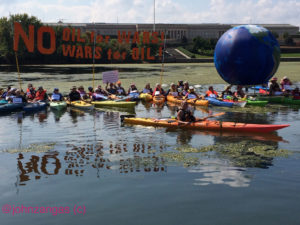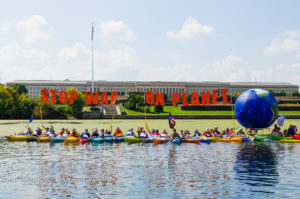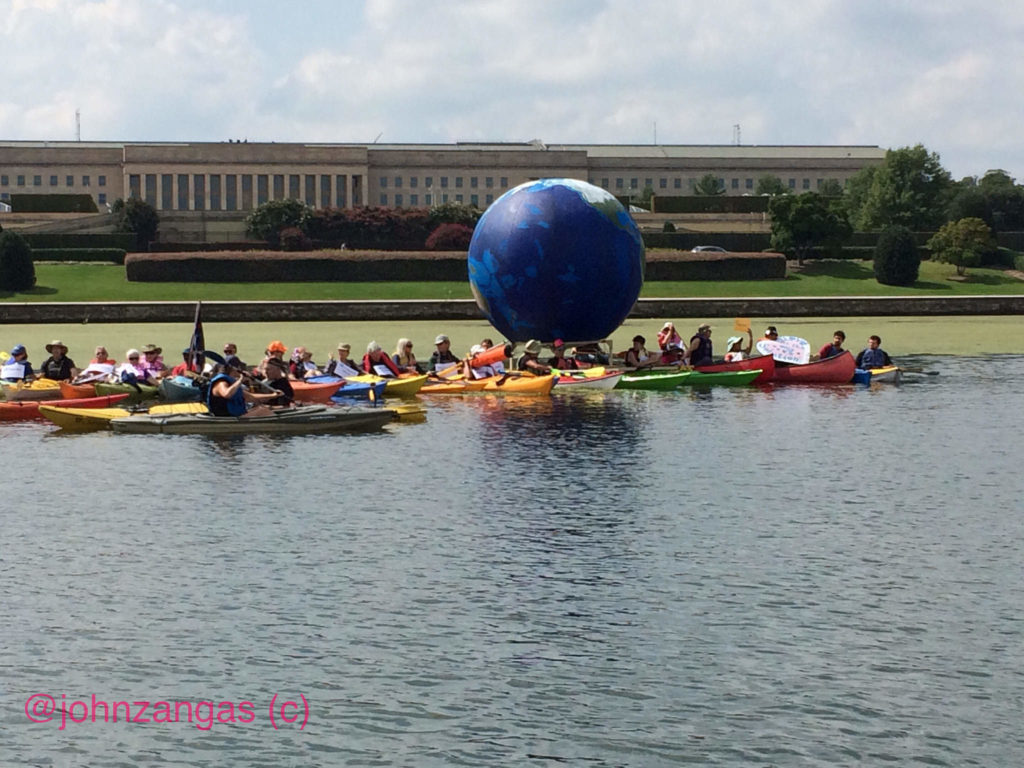By John Zangas and Anne Meado.
Arlington, Va. — On Sunday afternoon, the Backbone Campaign, World Without War, the Raging Grannies, and other peace and environmental groups staged the spectacular banner hoist using a flotilla of linked kayakers in the lagoon just off the Potomac. About 50 kayakers took part in the event which was caught on camera by media on a press boat nearby.
While many demonstrations are held at government buildings in the nation’s capital, you’ll see few at the Pentagon protesting against the world’s largest military. The reason is because security concerns make it very difficult for activists to get anywhere near it. But several environmental groups staged a never-tried-before naval approach by paddling kayaks to a point just outside the Pentagon exclusion zone. Kayakers launched their vessels into the lagoon just north of military complex along with a giant inflated earth replica and several large banners.
 The kayaktivists, as they call themselves, hoisted poles with the giant banners, which read, “Stop War On Planet” and “No Oils for War, No Wars for Oil!”
The kayaktivists, as they call themselves, hoisted poles with the giant banners, which read, “Stop War On Planet” and “No Oils for War, No Wars for Oil!”
The action drew attention to several concerns, including local upstream water pollution which Pentagon procurement is a contributor. The military also created hundreds of the EPA’s Superfund sites with abandoned bases and industrial facilities. Kayaktivists wore signs with chemical names of carcinogens released into the Potomac and Chesapeake by military contractors.
Environmentalists often challenge suppliers of fossil fuels: the oil, gas and coal industries. With this protest, the kayaktivists focused attention on the demand side, according to World Beyond War founder David Swanson. Climate activists have largely made a big omission by failing to target number world’s one consumer: the U.S. military. The Pentagon is the world’s largest consumer of petroleum and by extension, the world’s largest contributor to petroleum-related pollution and greenhouse gases.
“We should keep going after the supply, keep going after the the pipelines and the oil rigs but look at the demand as well. Look at the number one consumer of petroleum, look at the number one killer of the earth,” he said.
Swanson believes that peace activism and environmentalism go hand in hand. “If you care about the earth, then you have to care about peace,” he said.
 In terms of the 2017 discretionary spending, Swanson said that budget is not telling the whole story on how much is being spent on the U.S. armed forces. “If you look at the whole budget, discretionary and non-discretionary spending, you get well over a trillion on military spending,” he said. If any money is going to go toward altering the economy toward renewables and preparing for climate change, the discretionary funds going to the military is “where you have to take it,” he said.
In terms of the 2017 discretionary spending, Swanson said that budget is not telling the whole story on how much is being spent on the U.S. armed forces. “If you look at the whole budget, discretionary and non-discretionary spending, you get well over a trillion on military spending,” he said. If any money is going to go toward altering the economy toward renewables and preparing for climate change, the discretionary funds going to the military is “where you have to take it,” he said.
The flotilla was also joined by the Raging Grannies, a group of environmental octogenarians who sung several parodies of military tunes. In one parody, they inserted their own environmental message into the Marine Corps Hymn to advocate for protection of the earth “without the help of the U.S. Marines.”
Backbone Campaign executive director Bill Moyer spoke about the tactic of kayaktivism to support environmentalism in communities being affected by pollution. “We are able to leverage the accountability of elected officials to the local population that we are working with,” he said.










